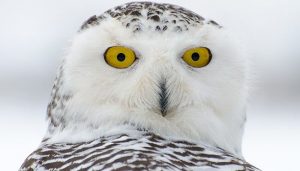Snowy Owls In Iowa
December 14th, 2021 by Ric Hanson
(Des Moines, Iowa) – Officials with the Iowa Department of Natural Resources report Snowy Owls are making their way into the state, looking for food on their way south. You can observe the winged wonders, but please, give them space so they can hunt undisturbed. If your presence changes the behavior of an owl (Ex: it flies or looks right at you) you’re too close and you may be causing undue stress. Do not approach an owl unless it is obviously injured or struggling to fly, and always consult a licensed wildlife rehabilitator before intervening.
Snowy Owls breed in the open landscapes of the Arctic Tundra. During summers with abundant food (particularly lemmings), many young are produced, and the following winter, many of those young owls disperse south into the US to look for winter prey. When large numbers of owls move south in winter it’s called an irruption. Although it’s not a large irruption year, at least a dozen snowy owls have been seen in Iowa so far this season, with many arriving in the last two weeks. Unlike other owls, Snowy Owls are active during the day (diurnal) and can be spotted in open areas, like agricultural fields and airports, looking for food. Snowy Owls are sit-and-wait predators and often sit in one spot for hours at a time. They commonly perch on wooden fence posts and telephone poles, or find a spot to sit on the ground.
Although some people may worry that Snowy Owls will be susceptible to heat stress in an unseasonably warm Iowa winter, there is little evidence to suggest that a few days of temperatures in the 70s will be too much for the birds to handle. In their breeding range, days in the 50s are common and Snowy Owls have been observed surviving the winter as far South as Florida where average daily highs are in the upper 60s all winter long. More pressing threats are human-related (Ex: collisions with vehicles and power lines).
The DNR is interested in learning more about Snowy Owls wintering in Iowa and the threats they face, so if you happen to find a dead Snowy Owl, please report it to Iowa DNR’s Avian Ecologist Anna Buckardt Thomas (anna.buckardt@dnr.iowa.gov, 515-823-3945) and/or the State Wildlife Veterinarian Dr. Rachel Ruden (rachel.ruden@dnr.iowa.gov, 515-823-8544).
If it is safe to do so, you may retrieve dead owls using gloves and a garbage bag. Keep in a cool place but avoid freezing until you can turn over to a wildlife biologist or conservation officer. Remember, unless you are transferring to the Iowa DNR or other permitted entity, it is illegal to be in possession of a migratory bird carcass under federal law.





